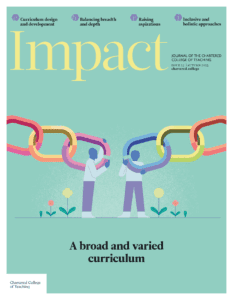Breadth and depth in curriculum: Advantages, disadvantages and strategies for balance
Written by: Jackie Greatorex and Martin Johnson

7 min read
JACKIE GREATOREX, PRINCIPAL RESEARCHER, CAMBRIDGE UNIVERSITY PRESS AND ASSESSMENT
MARTIN JOHNSON, SENIOR RESEARCHER, CAMBRIDGE UNIVERSITY PRESS AND ASSESSMENT
Abstract
In this thought piece, we consider messages from research literature on the relative impact of breadth and depth in curricula at both school and national levels. This debate is important since decision-making in curriculum design should have a robust evidence base that can lead to reliable and generalisable conclusions.
After considering the claims about the relative impact of breadth and depth, we ponder strategies to include both in ‘intended curricula’. We suggest that individual schools might use a T-shaped curriculum to simultaneously incorporate topic breadth as well as the deep exploration of selected topics. At a national level, curriculum developers may prioritise key concepts when making decisions about curriculum content selection. Finally, we highlight the importance of adapting curricula to local
Join us or sign in now to view the rest of this page
You're viewing this site as a guest, which only allows you to view a limited amount of content.
To view this page and get access to all our resources, join the Chartered College of Teaching (it's free for trainee teachers and half price for ECTs) or log in if you're already a member.
- Dempster ER (2024) A comparative study of breadth and depth of content in junior secondary biology syllabi in four jurisdictions. International Journal of Science Education 46(18): 1899–1921.
- Dixon C, Thomson J and Fricke S (2020) Language and reading development in children learning English as an additional language in primary school in England. Journal of Research in Reading 43(3): 309–328.
- Dolton PJ and Vignoles A (2002) Is a broader curriculum better? Economics of Education Review 21(5): 415–429.
- Mehta J (2015) Breadth and depth: Can we have it both ways? HTH Unboxed 14. Available at: https://hthunboxed.org/breadth-and-depth-can-we-have-it-both-ways/ (accessed 15 July 2025).
- Millar R (2011) Reviewing the National Curriculum for science: Opportunities and challenges. Curriculum Journal 22(2): 167–185.
- Murdock J (2008) Comparison of curricular breadth, depth, and recurrence and physics achievement of TIMSS Population 3 countries. International Journal of Science Education 30(9): 1135–1157.
- OECD (2020) Curriculum overload: A way forward. Available at: www.oecd.org/en/publications/curriculum-overload_3081ceca-en.html (accessed 15 July 2025).
- Paterson L (2023) Breadth of study at secondary school and the attainment and progression of university graduates in Scotland, 1960–2002. Higher Education 85: 717–738.
- Pratt K and Atkinson R (2020) How do some primary schools in England organise and implement the broader curriculum? Education 3–13 48(4): 357-364.
- Schwartz MS, Sadler PM, Sonnert G et al. (2009) Depth versus breadth: How content coverage in high school science courses relates to later success in college science coursework. Science Education 93(5): 798–826.
- Spencer S, Clegg J, Lowe H et al. (2017) Increasing adolescents’ depth of understanding of cross‐curriculum words: An intervention study. International Journal of Language & Communication Disorders 52(5): 652–668.
- Yanti M and Rahmadhani A (2023) Analysis of teacher interpretation of the depth and breadth of middle school level global warming material using ‘Content Representation’ (CoRe). Prisma Sains: Jurnal Pengkajian Ilmu dan Pembelajaran Matematika dan IPA IKIP Mataram 11(4): 1066–1075.
- Wyse D (2020) Breadth and balance: The essential elements of a recovery curriculum. In: IOE Blog, UCL. Available at: https://blogs.ucl.ac.uk/ioe/2020/09/03/breadth-and-balance-the-essential-elements-of-a-recovery-curriculum (accessed 15 July 2025).
0
0
votes
Please Rate this content
Please login to comment
0 Comments
Oldest
Newest
Most Voted
Inline Feedbacks
View all comments










